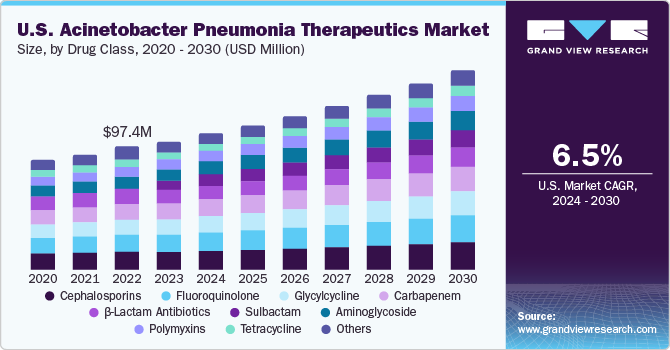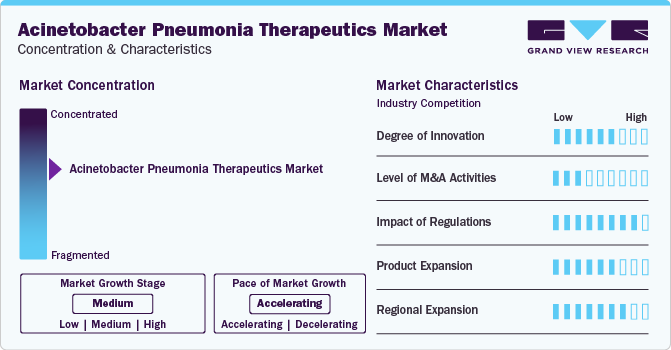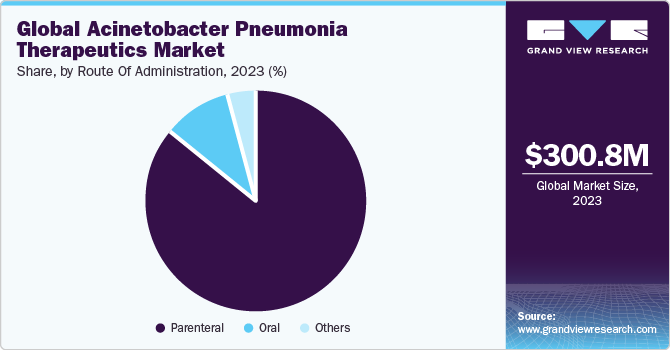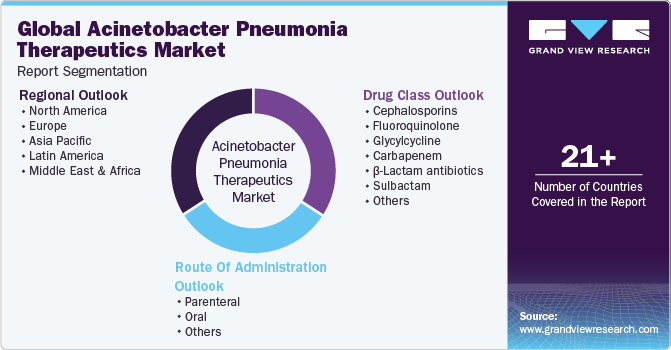- Home
- »
- Pharmaceuticals
- »
-
Acinetobacter Pneumonia Therapeutics Market Report, 2030GVR Report cover
![Acinetobacter Pneumonia Therapeutics Market Size, Share & Trends Report]()
Acinetobacter Pneumonia Therapeutics Market Size, Share & Trends Analysis Report By Drug Class (Xacduro, Polymyxins, Cephalosporins, Carbapenems), By Route Of Administration (Oral, Parenteral), By Region, And Segment Forecasts, 2024 - 2030
- Report ID: GVR-4-68040-252-2
- Number of Report Pages: 150
- Format: PDF, Horizon Databook
- Historical Range: 2018 - 2023
- Forecast Period: 2024 - 2030
- Industry: Healthcare
Market Size & Trends
The global acinetobacter pneumonia therapeutics market size was estimated at USD 300.81 million in 2023 and is projected to grow at a CAGR of 6.70% from 2024 to 2030. The market growth is driven by the increasing prevalence of acinetobacter pneumonia bacterial infection, which poses a significant threat to public health. The market is shaped by an urgent need for effective treatments that address the limitations of current antibiotic options, such as resistance and side effects. Ongoing R&D efforts aim to discover novel therapeutics that can overcome these challenges. Market trends and future projections indicate a promising growth trajectory, driven by advancements in medical technology and a focus on personalized medicine.

The market represents a critical area of focus for healthcare providers, researchers, and pharmaceutical companies in their quest to develop effective and safe treatments for acinetobacter pneumonia. Antimicrobial resistance (AMR) has emerged as a pressing global health crisis, with bacteria developing resistance to antibiotics, leading to a significant number of illnesses and deaths. The situation is particularly critical with acinetobacter baumannii, known as carbapenem-resistant Acinetobacter baumannii (CRAB), which has been reclassified by the CDC from a serious to an urgent hazard level due to its high resistance and potential for causing severe infections. In 2017 alone, CRAB infections resulted in USD 281 million in healthcare costs, 8,500 hospitalizations, and 700 deaths in the U.S., highlighting the urgent need for innovative treatments and research.
The CDC projects that without substantial investment in understanding AMR and developing new or alternative therapies, by 2050, at least 10 million individuals could die from multidrug-resistant organisms. According to the OECD, approximately 3.8 million people in the EU alone acquire healthcare-associated infections (HAIs) annually, with 90,000 deaths attributed to HAIs. This alarming trend is fueled by the growing elderly population, the rise in chronic diseases, and the increasing resistance to available antibiotics. The market's growth is further propelled by the ongoing R&D activities of major pharmaceutical companies to develop novel therapeutics for HAIs. For instance, the FDA's approval of Merck & Co., Inc.’s drug Zerbaxa for the treatment of ventilator-associated bacterial pneumonia (HABP/VABP) and hospital-acquired bacterial pneumonia underscores the urgency and potential for market expansion.
In addition, research efforts in the field of Acinetobacter pneumonia therapeutics focus on combatting the rise of carbapenem-resistant Acinetobacter baumannii-calcoaceticus complex (CRAB) infections, especially ventilator-associated bacterial pneumonia (VABP) and hospital-acquired bacterial pneumonia (HABP). Notably, the FDA's approval of sulbactam-durlobactam (marketed as Xacduro) represents a significant advancement in addressing CRAB infections, as evidenced by the positive results from the Phase 3 Attack Trial. In addition, the CDC has elevated the threat level of CRAB to "concern", emphasizing the urgent need for new therapeutic approaches.
Market Concentration & Characteristics
The market for acinetobacter pneumonia therapeutics is currently experiencing a phase of rapid growth, driven by advancements in treatment approaches and increasing prevalence of acinetobacter infections worldwide. Technological innovations in antimicrobial therapies and diagnostic tools are contributing to this growth trajectory, enabling more effective management of the disease

The market is characterized by a low-to-moderate level of merger and acquisition (M&A) and collaboration, indicating a landscape characterized by stable competition and a focus on internal development rather than external consolidation
Regulatory trends for acinetobacter pneumonia therapeutics are evolving towards stricter evaluation criteria. Especially for developing new antibiotics for Acinetobacter pneumonia faces challenges such as rapid antimicrobial resistance emergence, limited detection of genetic resistance mechanisms, and difficulty in pulmonary penetration of drugs. Alternative strategies like peptides and nanoparticles are essential amid limited antibiotic options, emphasizing innovation against antimicrobial resistance
Product substitutes for acinetobacter pneumonia therapeutics, may include combination therapies, adjunctive treatments, and infection control measures aimed at reducing transmission rates
The market is expanding regionally, enhancing access to effective treatments in both developed and developing regions. Strategies may include partnerships with local healthcare providers, educational initiatives to raise awareness about the importance of infection control, and the development of affordable treatment options tailored to the needs of different healthcare systems
Drug Class Insights
The cephalosporins segment accounted for the largest share of 14.4% in 2023. The increasing antimicrobial resistance in acinetobacter baumannii, a significant pathogen causing pneumonia, has limited therapeutic options, making cephalosporins a crucial choice for treatment. Studies have shown that cephalosporins remain the first line of treatment when isolates retain susceptibility to this class of antibiotics, highlighting their effectiveness in combating multidrug-resistant Acinetobacter infections. Drugs such as Ceftazidime and Cefiderocol are used under this drug class for the treatment of acinetobacter pneumonia.
The sulbactam segment is projected to grow at the fastest CAGR over the forecast period due to its approval for treating hospital-acquired bacterial pneumonia (HABP) and ventilator-associated bacterial pneumonia (VABP) in adults. Xacduro is the newly launched drug under the sulbactam drug class. Xacduro, a combination of sulbactam and durlobactam, addresses the critical need for effective treatments against multidrug-resistant Acinetobacter baumannii-calcoaceticus complex strains. In addition, the clinical efficacy and safety demonstrated in trials like ATTACK highlight Xacduro's potential as a valuable addition to the treatment armamentarium for Acinetobacter pneumonia, further supporting its projected CAGR over the forecast period.
Route of Administration Insights
The parenteral route of administration segment held a dominant share in 2023 and is expected to grow at a CAGR of 6.9% from 2024 to 2030 due to the severity and critical nature of Acinetobacter infections. Rapid and direct delivery of antibiotics via the IV route ensures rapid absorption and efficacy, making it the preferred method for treating severe infections such as acinetobacter pneumonia. Drugs such as Xacduro (sulbactam for injection; durlobactam for injection), polymyxins (colistin), carbapenems, and aminoglycosides are all administered intravenously to combat Acinetobacter Pneumonia effectively. The IV route's dominance aligns with the urgency and complexity of treating Acinetobacter pneumonia, emphasizing the importance of rapid and targeted therapy for optimal patient outcomes.

The oral route of administration segment held the second-largest revenue share in 2023 due to the immediate treatment accessibility and widespread availability of oral antibiotics. Oral medications offer a convenient option for managing acinetobacter pneumonia, ensuring timely delivery, and promoting adherence to treatment regimens. As the global market grows steadily, the increasing adoption of oral therapies reflects a broader trend favoring oral medication use worldwide, the oral route plays a key role in providing effective and accessible treatment options for acinetobacter pneumonia.
Regional Insights
North America acinetobacter pneumonia therapeutics market dominated the market and accounted for a 37.31% share in 2023, due to the availability of newly launched treatments such as Xacduro, FDA approvals, and well-established healthcare infrastructure. The region has a robust healthcare system, stringent regulatory processes, heightened awareness, and extensive research efforts. In addition, its geographic accessibility and concentration of patients contribute to its leadership role. These factors collectively contribute to North America's pivotal role in advancing therapeutic interventions for Acinetobacter pneumonia, solidifying its position as a key player in the market.

U.S. Acinetobacter Pneumonia Therapeutics Market Trends
The acinetobacter pneumonia therapeutics market in the U.S. is expected to grow over the forecast period due to the high prevalence of acinetobacter-related pneumonia cases, limited approved therapies, and a restricted antibacterial pipeline. The market presents growth opportunities fueled by increasing multidrug-resistant strains and demand for more effective treatments. Key pharmaceutical players, such as Pfizer, Merck, and GlaxoSmithKline, are actively involved in product innovation and strategic collaborations to address antibiotic resistance challenges. The U.S. market is forecasted to significantly increase by 2030, driven by ongoing research, treatment advancements, and collaborations across industry, research, and healthcare sectors.
Europe Acinetobacter Pneumonia Therapeutics Market Trends
The Europe acinetobacter pneumonia therapeutics market shows steady growth driven by rising drug-resistant infections and hospital-acquired pneumonia cases. Ongoing research contributes to developing tailored medication and improving patient outcomes. Pneumonia's high incidence, especially among the elderly and immunocompromised, drives demand for effective therapies. Demographic shifts toward an aging population create further market opportunities.
The acinetobacter pneumonia therapeutics market in the UK shows steady growth due to increasing drug-resistant infections and hospital-acquired pneumonia cases. Key drivers include the rise of multidrug-resistant strains, advancements in diagnostics, and the demand for effective treatments.
The France acinetobacter pneumonia therapeutics market is driven by increasing infections, research on virulence factors and resistance, and exploration of new antimicrobials. This innovation aims to improve treatment outcomes and develop safer options.
The acinetobacter pneumonia therapeutics market in Germany is expected to grow over the forecast period due to significant research interest, evident from increasing PubMed publications. The spatial distribution reveals concentrations in regions, such as North Rhine-Westphalia, Hesse, and Baden-Wuerttemberg. This underscores a strong regional focus on understanding and treating Acinetobacter infections, likely influenced by local healthcare infrastructure and research institutions.
Asia Pacific Acinetobacter Pneumonia Therapeutics Market Trends
The Asia Pacific acinetobacter pneumonia therapeutics market is expanding due to high prevalence, increased healthcare spending, population growth, medical advancements, regulatory support, and improved awareness. Rising instances of pneumonia cases and a growing medical tourism industry contribute to market growth. Moreover, rising healthcare access and awareness in developing nations present substantial growth opportunities, allowing more patients to access diagnosis and treatment for drug-resistant infections like Acinetobacter pneumonia.
The China hiacinetobacter pneumonia therapeutics market is expected to grow over the forecast period due to increasing infection prevalence, antimicrobial resistance, rising healthcare expenditure, and expanding healthcare infrastructure. Anticipated growth stems from ongoing research and development, focusing on new antibiotics and therapeutic strategies.
The acinetobacter pneumonia therapeutics market in Japan is expected to grow over the forecast period due to factors such as the prevalence of carbapenem-resistant Acinetobacter baumannii (CR-AB) isolates and resistance to multiple antibiotics. Studies highlight the presence of carbapenemase genes like blaOXA-23, blaOXA-72, and blaNDM-1, exacerbating treatment complexities. Market dynamics are driven by the need for innovative therapeutics to manage CR-AB infections effectively. Future growth hinges on research into geographic distribution and resistance mechanisms, emphasizing the development of new treatments tailored to these challenges.
Latin America Acinetobacter Pneumonia Therapeutics Market Trends
The Latin America acinetobacter pneumonia therapeutics market is expected to grow over the forecast period, fueled by emerging markets in developing countries, an increased focus on preventive healthcare, and the impact of lower respiratory infections. These factors highlight a significant need for innovative pneumonia treatments.
The acinetobacter pneumonia therapeutics market in Brazil shows global growth trends, driven by factors like rising drug-resistant strains and increasing hospital-acquired pneumonia cases.
MEA Acinetobacter Pneumonia Therapeutics Market Trends
The MEA acinetobacter pneumonia therapeutics market is expected to grow over the forecast period due to rising infection prevalence, increased research, molecular diagnostic advancements, and a preference for targeted therapy. Urgent medical needs drive intensified R&D efforts. Molecular diagnostics enable rapid, precise diagnoses, enhancing patient outcomes. Targeted drug therapy gains favor for its efficacy and reduced resistance risk.
The acinetobacter pneumonia therapeutics market in Saudi Arabia is expected to grow over the forecast period due to rising multidrug-resistant strain prevalence, infection control focus, and robust healthcare infrastructure. These factors highlight the urgent need for effective treatments in combating nosocomial infections. Saudi Arabia's investment in healthcare infrastructure supports diagnosis and treatment, fostering market expansion and innovation against drug-resistant pathogens.
Key Acinetobacter Pneumonia Therapeutics Company Insights
Some of the leading players in the market include Sanofi SA, GlaxoSmithKline plc, Pfizer Inc, Bayer AG, Zimmer Biomet, and Novartis AG. Different strategies are undertaken by the players to strengthen their market positions. Companies are involved in expanding their market presence by signing agreements with other players in emerging economies. Product approval is another strategy adopted by these companies.
Emerging players, such as Flexion Therapeutics, Inc., Arthrex, Inc., and Royal Biologics, are following different strategic initiatives, such as collaborations and partnerships, with key participants and other players, capturing niche areas of the supply chain, such as distribution and delivery of products & solutions, to establish themselves.
Key Acinetobacter Pneumonia Therapeutics Companies:
The following are the leading companies in the acinetobacter pneumonia therapeutics market. These companies collectively hold the largest market share and dictate industry trends.
- Pfizer Inc.
- Merck & Co., Inc.
- GlaxoSmithKline Plc (GSK)
- AstraZeneca Plc
- Novartis AG
- Johnson & Johnson
- Sanofi S.A.
- Bayer AG
- Basilea Pharmaceutica
Recent Developments
-
In January 2024, a research study published in the Nature Journal reported in their studies a new clinical candidate effective against drug-resistant strains of Carbapenem-resistant Acinetobacter baumannii (Crab) in mouse models of pneumonia and sepsis. The Zosurabalpin is currently being tested for human trials and could prove to be a beneficial antibiotic for treating drug-resistance microorganisms
-
In May 2023, Innoviva Specialty Therapeutics announced FDA approval for XACDURO (sulbactam for injection; durlobactam for injection) for treating hospital-acquired and ventilator-associated bacterial pneumonia caused by susceptible Acinetobacter strains, marking the first pathogen-targeted therapy for Acinetobacter
-
In May 2019, CARB-X, a global nonprofit partnership, awarded funding to Debiopharm International SA for the development of ANTIBIOTICS for the treatment of Acinetobacter pneumonia
Acinetobacter Pneumonia Therapeutics Market Report Scope
Report Attribute
Details
Market size value in 2024
USD 319.2 million
Revenue forecast in 2030
USD 470.96 million
Growth rate
CAGR of 6.70% from 2024 to 2030
Actual Years
2018 - 2023
Forecast period
2024 - 2030
Quantitative units
Revenue in USD million/billion and CAGR from 2024 to 2030
Report coverage
Revenue forecast, company ranking, competitive landscape, growth factors, and trends
Segments covered
Drug class, route of administration, region
Regional scope
North America; Europe; Asia Pacific; Latin America; MEA
Country scope
U.S.; Canada; UK; Germany; Spain; Denmark; Sweden; Norway; France; Italy; China; India; Japan; Thailand; South Korea; Australia; Brazil; Mexico; Argentina; South Africa; Saudi Arabia; UAE; Kuwait
Key companies profiled
Sanofi SA; GlaxoSmithKline Plc; Pfizer Inc.; Bayer AG; Zimmer Biomet; Novartis AG; Anika Therapeutics; Assertio Therapeutics, Inc.; Bioventus; Ferring Pharmaceuticals Inc.
Customization scope
Free report customization (equivalent up to 8 analysts working days) with purchase. Addition or alteration to country, regional & segment scope
Pricing and purchase options
Avail customized purchase options to meet your exact research needs. Explore purchase options
Global Acinetobacter Pneumonia Therapeutics Market Report Segmentation
This report forecasts revenue growth at the global, regional, and country levels and provides an analysis of the latest trends in each sub-segments from 2018 to 2030. For this study, Grand View Research has segmented the global acinetobacter pneumonia therapeutics market report on the basis of drug class, route of administration, and region:

-
Drug Class Outlook (Revenue, USD Million, 2018 - 2030)
-
Cephalosporins
-
Fluoroquinolone
-
Glycylcycline
-
Carbapenem
-
β-Lactam antibiotics
-
Sulbactam
-
Aminoglycoside
-
Polymyxins
-
Tetracycline
-
Sulfonamide
-
Others
-
-
Route of Administration Outlook (Revenue, USD Million, 2018 - 2030)
-
Parenteral
-
Oral
-
Others
-
-
Regional Outlook (Revenue, USD Million, 2018 - 2030)
-
North America
-
U.S.
-
Canada
-
-
Europe
-
Germany
-
UK
-
Spain
-
France
-
Italy
-
Denmark
-
Sweden
-
Norway
-
-
Asia Pacific
-
Japan
-
China
-
India
-
South Korea
-
Australia
-
Thailand
-
-
Latin America
-
Brazil
-
Mexico
-
Argentina
-
-
MEA
-
South Africa
-
Saudi Arabia
-
UAE
-
Kuwait
-
-
Frequently Asked Questions About This Report
b. The global acinetobacter pneumonia therapeutics market size was estimated at USD 300.81 million in 2023 and is expected to reach USD 319.2 million in 2024.
b. The global acinetobacter pneumonia therapeutics market is expected to grow at a compound annual growth rate of 6.70% from 2024 to 2030 to reach USD 470.96 million by 2030.
b. North America dominated the acinetobacter pneumonia therapeutics market with a share of 37.31% in 2023. Available of newly launched treatments such as Xacduro, FDA approvals, and well-established healthcare infrastructure are factors fueling the Acinetobacter pneumonia therapeutics market in North America.
b. Some key players operating in the acinetobacter pneumonia therapeutics market include Sanofi SA, GlaxoSmithKline plc, Pfizer Inc, Bayer AG, Zimmer Biomet, Novartis AG, Anika Therapeutics, Assertio Therapeutics, INC., Bioventus, Ferring Pharmaceuticals Inc..
b. Key factors that are driving the acinetobacter pneumonia therapeutics market growth include Increasing incidence of Acinetobacter infections, Increasing prevalence of antibiotic resistance, and increasing research & development and funding.
Share this report with your colleague or friend.
![gvr icn]()
NEED A CUSTOM REPORT?
We can customize every report - free of charge - including purchasing stand-alone sections or country-level reports, as well as offer affordable discounts for start-ups & universities. Contact us now
![Certified Icon]()
We are GDPR and CCPA compliant! Your transaction & personal information is safe and secure. For more details, please read our privacy policy.
We are committed towards customer satisfaction, and quality service.
"The quality of research they have done for us has been excellent."





